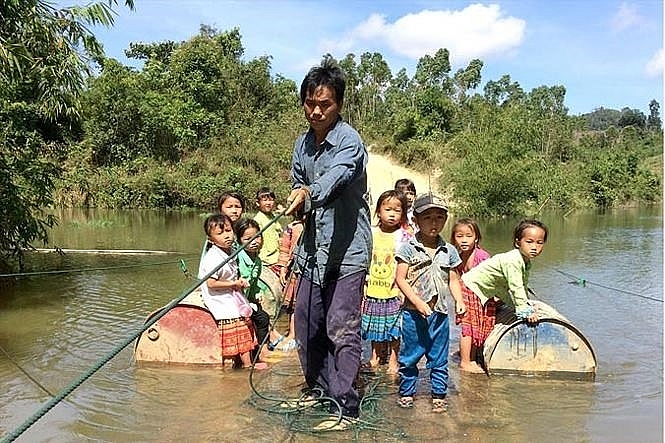Highlands people bet their lives to secure livelihood
 |
| Children of Ea Rot go to school on a raft. - Photo tienphong.vn |
In the last two years, many roads in Krông Bông District have flooded once the rainy season starts.
Local residents have no choice but to use primitive rafts to go to work and school.
On one side of the river lies the farm of Vang Seo De, a local resident. On summer days when the water level drops, De and his family members can swim across the narrow stream to reach the farm. During the rainy season, however, the distance from this bank to another reaches up to 60m.
People in the neighbourhood pooled their money to make a raft made from bamboo sticks and light timber. On the river banks, two piles to hold a rope were built.
When people board the raft, they pull the rope to cross the other side.
At a time, a raft can safely carry only a few passengers. However, at peak hours, people flock onto the shaky raft with their tools, leading to potential capsizing.
Hau Thi Dua, a local resident, recalled last March that the raft transporting her, her one-year-old child and other people flipped. They were fortunately rescued afterward. Despite the accident, Dua continues to cross the river on the raft, she told Tien Phong (Vanguard) Newspaper.
Vang Seo Mang, head of Ea Rot Village, said locals had no choice. The rainy season turns the village into a small oasis, disconnected from other places by mountains and streams. Even the village itself divided into smaller parts because of the rising water.
As well as being people’s main transportation, rafts are used to load local agricultural products. Harvest seasons, therefore, feature a lot of capsizing.
Last year, 48 motorbikes were driven into springs around the village, Mang said. The cost of salvaging and fixing those vehicles has become a burden for owners.
Unable to take the accidents any longer, some people decided to abandon their farms.
Giang A Trang in Cu Te Commune, Cu Pui District said that last year his family sowed 2.5ha of cassava but could only harvest 10 tonnes due to heavy rains.
Shipping agricultural products is another challenge. To overcome the 20km-long forest road with high hills and yawning gulfs, they have to hire speacialised trucks to transport goods. The shipment will then be divided into smaller compartments to get across Khóa Village suspension bridge, one of few bridges in the locality.
Since these costs make turning a profit difficult, many people quit.
“Only by living here can you understand how vulnerable we are. We work hard to cultivate, the harvest season then comes along with heavy rains. We’re only tossing a dice with our lives crossing the roaring river to harvest crops, we have to face traders who always want to reduce the prices,” said Y Bra Nie in Khoa Village.
“One way or another, we cannot give up, otherwise, tomorrow will be days of starvation,” he added.
Nguyen Van Tam, head of Cư Pui Commune People’s Committee, said that six of its 13 villages were often isolated. Hiding inside the mountains is Ea Rot Ward. Commune authorities donate money to buy ropes, plastic barrels and wooden boards for people to structure durable rafts. They also report about the area to the provincial people’s committee.
The boat capsize on Krong Ana River at the end of 2016 which killed three people left a stain in the memory of people in Ea Trul Commune.
Cao Van Tho, the commune head, told Viet Nam News that although the Ministry of Transportation had decided to build a suspension bridge in the area, there had been no progress on the project in two years.
“As most local residents are poor, it is impossible to build a bridge themselves. Therefore, we are still waiting for the Government’s support,” he said.
According to Dak Lak Province Department of Transport, Ministry of Transport approved the construction 111 bridges in 13 localities with the investment of VND193 billion (US$8.5 million). Thọ, however, said that he had not been notified about the plan.
What the stars mean:
★ Poor ★ ★ Promising ★★★ Good ★★★★ Very good ★★★★★ Exceptional
 Tag:
Tag:
Related Contents
Latest News
More News
- Protect what’s next: towards a future free from meningococcal group B disease (December 05, 2025 | 18:00)
- New ILO report offers policy recommendations for disability inclusion (December 04, 2025 | 15:18)
- Maternal job loss may affect children’s mental health, research shows (December 03, 2025 | 19:11)
- Women lead Vietnam’s shift to climate-resilient agriculture (December 03, 2025 | 19:10)
- Experts highlight unpaid care work as key barrier to gender equality (December 03, 2025 | 15:15)
- Opportunities and inequalities for women workers in Vietnam's garment industry (December 03, 2025 | 09:00)
- Vietjet flights carry love to devastated central region (November 28, 2025 | 11:35)
- New initiative to boost the fight against domestic violence (November 26, 2025 | 10:00)
- South Korea funds IOM relief for Vietnam’s typhoon-affected communities (November 24, 2025 | 15:33)
- AI and human-centred values set to shape the future of HR in Vietnam (November 21, 2025 | 18:04)
























 Mobile Version
Mobile Version